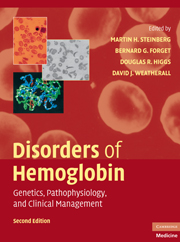Book contents
- Frontmatter
- Contents
- List of Contributors
- Foreword, by H. Franklin Bunn
- Preface
- Introduction, by David J. Weatherall
- SECTION ONE THE MOLECULAR, CELLULAR, AND GENETIC BASIS OF HEMOGLOBIN DISORDERS
- 1 A Developmental Approach to Hematopoiesis
- 2 Erythropoiesis
- 3 The Normal Structure and Regulation of Human Globin Gene Clusters
- 4 Nuclear Factors That Regulate Erythropoiesis
- 5 Molecular and Cellular Basis of Hemoglobin Switching
- 6 Structure and Function of Hemoglobin and Its Dysfunction in Sickle Cell Disease
- 7 Hemoglobins of the Embryo, Fetus, and Adult
- SECTION TWO PATHOPHYSIOLOGY OF HEMOGLOBIN AND ITS DISORDERS
- SECTION THREE α THALASSEMIA
- SECTION FOUR THE β THALASSEMIAS
- SECTION FIVE SICKLE CELL DISEASE
- SECTION SIX OTHER CLINICALLY IMPORTANT DISORDERS OF HEMOGLOBIN
- SECTION SEVEN SPECIAL TOPICS IN HEMOGLOBINOPATHIES
- SECTION EIGHT NEW APPROACHES TO THE TREATMENT OF HEMOGLOBINOPATHIES AND THALASSEMIA
- Index
- Plate section
- References
6 - Structure and Function of Hemoglobin and Its Dysfunction in Sickle Cell Disease
from SECTION ONE - THE MOLECULAR, CELLULAR, AND GENETIC BASIS OF HEMOGLOBIN DISORDERS
Published online by Cambridge University Press: 03 May 2010
- Frontmatter
- Contents
- List of Contributors
- Foreword, by H. Franklin Bunn
- Preface
- Introduction, by David J. Weatherall
- SECTION ONE THE MOLECULAR, CELLULAR, AND GENETIC BASIS OF HEMOGLOBIN DISORDERS
- 1 A Developmental Approach to Hematopoiesis
- 2 Erythropoiesis
- 3 The Normal Structure and Regulation of Human Globin Gene Clusters
- 4 Nuclear Factors That Regulate Erythropoiesis
- 5 Molecular and Cellular Basis of Hemoglobin Switching
- 6 Structure and Function of Hemoglobin and Its Dysfunction in Sickle Cell Disease
- 7 Hemoglobins of the Embryo, Fetus, and Adult
- SECTION TWO PATHOPHYSIOLOGY OF HEMOGLOBIN AND ITS DISORDERS
- SECTION THREE α THALASSEMIA
- SECTION FOUR THE β THALASSEMIAS
- SECTION FIVE SICKLE CELL DISEASE
- SECTION SIX OTHER CLINICALLY IMPORTANT DISORDERS OF HEMOGLOBIN
- SECTION SEVEN SPECIAL TOPICS IN HEMOGLOBINOPATHIES
- SECTION EIGHT NEW APPROACHES TO THE TREATMENT OF HEMOGLOBINOPATHIES AND THALASSEMIA
- Index
- Plate section
- References
Summary
INTRODUCTION
Hemoglobin has evolved to be an efficient oxygen (O2) transporter. Its function, understood in terms of a two-state model of allostery, serves as a paradigm for many other proteins. A single β-globin gene (HBB glu6val) point mutation resulting in sickle hemoglobin (HbS) is the proximate cause of sickle cell disease (Chapter 19). The primary cause of the disease is HbS polymerization that injures and deforms the sickle erythrocyte, causing many pathological consequences discussed elsewhere in this book.
STRUCTURAL ASPECTS OF HEMOGLOBIN
Hemoglobin is a 64-kD, nearly spherical protein with a diameter of approximately 5.5 nm. Its three-dimensional structure was solved by Max F. Perutz who discussed the molecular anatomy and physiology of hemoglobin in the first edition of this book. It is a dimer of dimers, with two α subunits and two β subunits (Fig. 6.1). The α chains have 141 amino acid residues and the β chains have 146 residues. Each of the α and β chains resemble each other closely in both secondary (α helical) and tertiary structure. Moreover, even though the primary amino acid sequence is different, each subunit also resembles myoglobin, a heme-containing globin having only one subunit in both secondary and tertiary structure. Generally, nonpolar groups are found in the interior of the subunits and polar residues are found on the surface. The SH group of the cysteine at position 93 of the β chain is exposed to solvent in the oxygenated form of hemoglobin, but it is partially hidden when hemoglobin is deoxygenated.
Information
- Type
- Chapter
- Information
- Disorders of HemoglobinGenetics, Pathophysiology, and Clinical Management, pp. 101 - 118Publisher: Cambridge University PressPrint publication year: 2009
